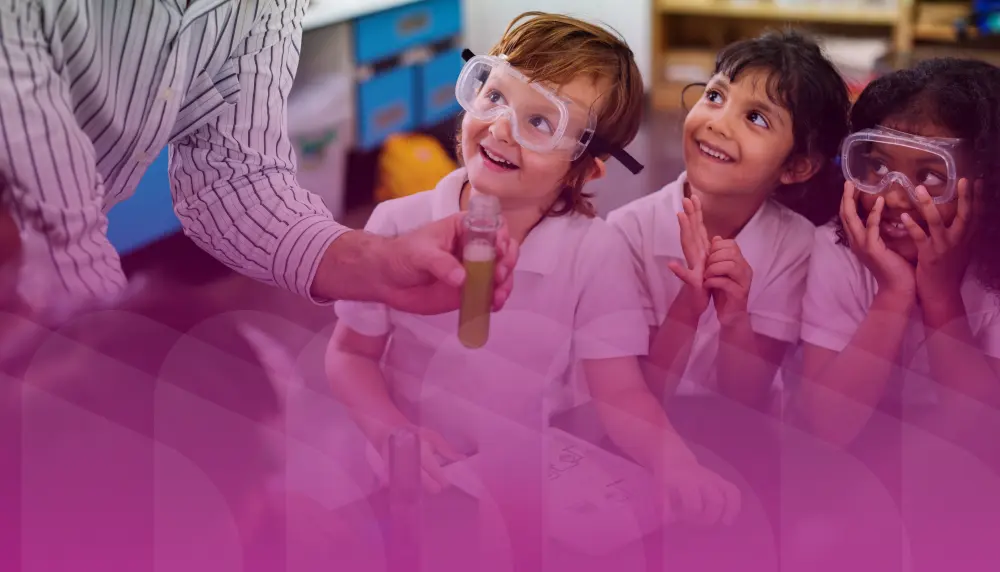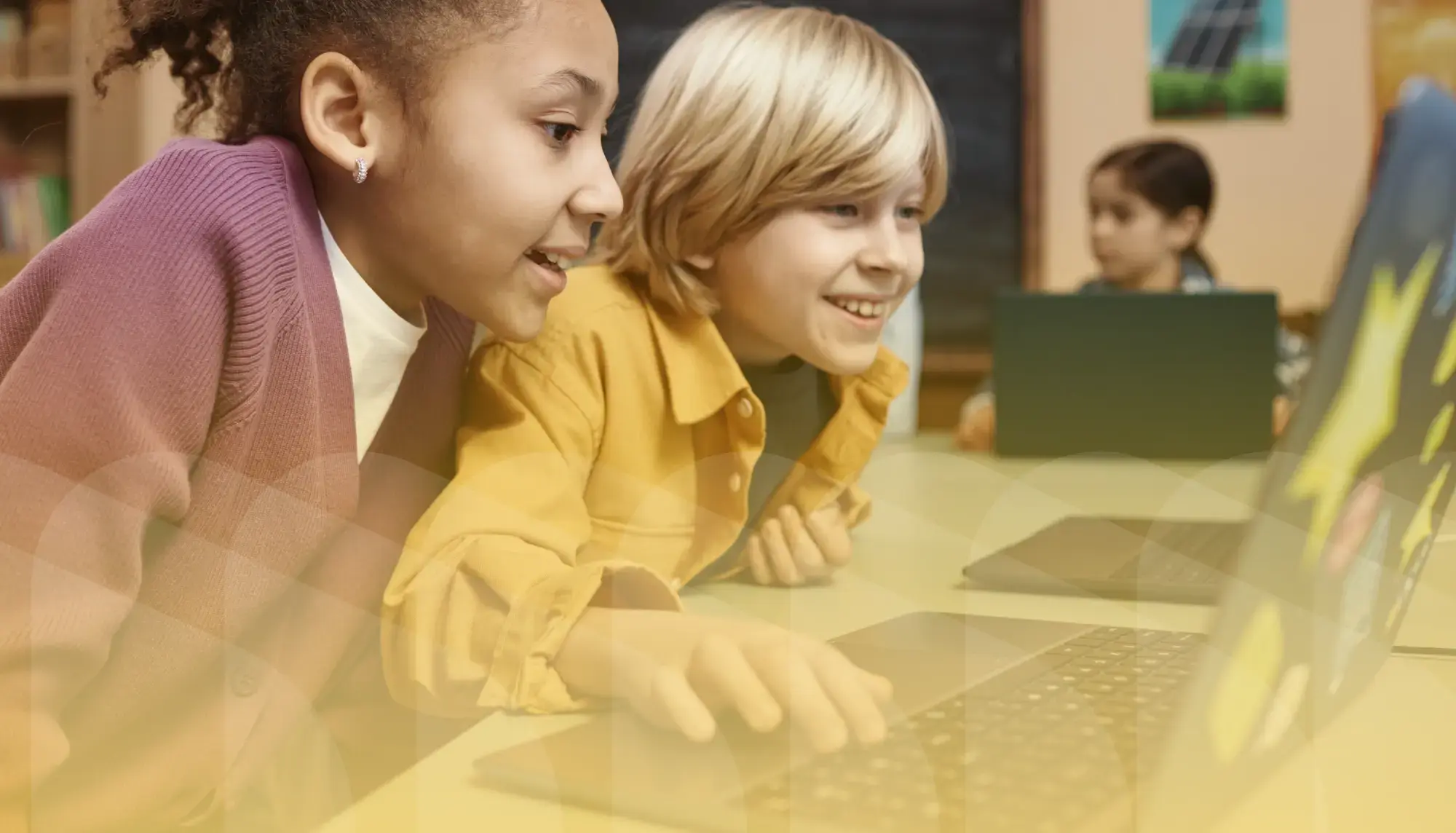
Hollywood depicts passive learning perfectly. The teacher walks in, pops in a movie, and belts out, "Take notes! There will be a test," and no one does anything. What is active learning, then? It flips the script.
The lecture finds a new role; the students take center stage.
Many phrases champion active learning and bemoan the more traditional passive approach. You might hear a teacher refer to legacy styles of teaching as "sit and get," or another encourage you to be a "guide on the side" rather than a "sage on the stage."
The concept of active learning is simple. A widely adopted definition, though? Not so easy.
So, let's find common ground.
What is active learning?
The issue of defining active learning stems from the term's broad use in theory and pedagogical approaches. It's used quite differently in a second-grade math class than in a music theory lecture hall.
Chemical Engineering professor Michael Prince defines active learning as "the process of having students engage in some activity that forces them to reflect upon ideas and how they are using those ideas."
The activity and the setting may change, but active learning places students at the forefront.
Let's peek into a fourth-grade classroom.
Groups of students discuss a question written on the board. The teacher stops to listen and joins the discourse at a table where confused looks abound. The guide on the side provides clarification. What is active learning? It’s light bulb moments. Conversations, excitement, and learning momentum continue at the table.
Active learning vs. passive learning
What you see in the fourth-grade classroom then is active learning. "Some activity" moves the individuals' minds toward reflection, discussion, and ownership of learning. In contrast to passive learning, where the instructor communicates their knowledge from the front of the room or within a recorded lecture with little to no student input, active learning produces excitement and helps generate relevant questions and considerations. Students often teach one another. The instructor monitors class input and adjusts instruction based on conversations, questions, and answers.
The lecture remains necessary but receives a new place in the lesson.
Top active learning strategies
Thankfully, advancements in education technology afford active learning opportunities beyond the classroom and in asynchronous learning environments. Video pedagogy provides new and engaging opportunities to boost retention and foster deep learning.
K-12 teachers and higher education faculty utilize active learning in many ways. Some of the top active learning examples they use are:
- Peer teaching
- Debates
- Roleplay
- Minute paper
- Opinion poll
- Three-step interviews
- Jigsaw
- Concept maps
- Fishbowl
- Dotmocracy
- Round table
- Group text reading
- Case studies
One of the most apparent examples of active learning techniques on a large scale is the flipped classroom. Project-based learning (PBL) falls under active learning and deeply involves students in learning.
WATCH: Project-based learning for the win with WeVideo.
Extended viewing: Hear how other educators teach with video in our panel discussion, The Power of Multimedia as a Pedagogy.
In answering “What is active learning?,” it's also important to know the learning theories and theorists behind the term.
Who came up with active learning?
Active learning evolved from a learning theory known as constructivism. Its tenets are offshoots from cognitive theory and launched from the minds of great thinkers like Jean Piaget, Maria Montessori, Jerome Bruner, Lev Vygotsky, and John Dewey, to name a few.
Observe a child. When infants and toddlers play, their learning often comes through sensory input.
Their natural inclinations gravitate toward active learning through play and exploration — what Jean Piaget termed the Sensorimotor Stage of Cognitive Development.
Why does active learning matter?
All the intentional and unintentional lessons a child acquires through life experiences shape them as a learner. The prior knowledge they gain serves as a foundation for future learning opportunities. Active learning matters since it encompasses how we’re wired to learn best.
In “Democracy and Education”, John Dewey answered “What is active learning?,” when he wrote, "there is no such thing as genuine knowledge and fruitful understanding except as the offspring of doing. The analysis and rearrangement of facts, which is indispensable to the growth of knowledge and power of explanation and right classification, cannot be attained purely mentally — just inside the head. Men have to do something to the things when they wish to find out something."

What are the principles of active learning?
Teachers must understand the tenets of active learning to use it effectively:
1. We learn based on experience
Prior knowledge is all the lessons a person carries with them based on what they’ve learned throughout their lives. Building rapport with students and knowing them personally is a crucial component of helping young people succeed academically.
2. We learn in context
Fact and rote memorization do little for our minds if operating within a vacuum. In his book "Range: Why Generalists Triumph in a Specialized World," David Epstein documents how some of the greatest thinkers solved what was once deemed unsolvable using information seemingly unrelated to the issue.
3. We learn via social interaction
Active learning is collaborative and cooperative. When teachers turn learners into instructors using the power of video, all types of conversations and opportunities blossom.
WATCH: Video-based learning allows students to show what they know through multimedia, like in this digital citizenship project.
4. We learn from our brains
Obviously. It goes without saying, but the mind is the center of learning. Hands-on activities and working with peers are crucial to actively learning, but learning happens and expands within the mind, making metacognition — thinking about thinking — so important.
5. We learn best when we're motivated
It's easier to learn when you're interested. Not that the topic must always appeal to all, but the better the delivery, the better the learning outcome.
6. We learn as we learn
At Grange Hall Elementary School, students use WeVideo to make engaging morning announcements. These young people are learning as they learn. When they reposition lights while recording, they learn about shadows; audio recording teaches sound engineering. They start conceptualizing and organizing their knowledge. What is active learning? It’s understanding a lesson teaches much more than one objective.
Maria Montessori proved constructivist philosophies effective. The Italian doctor and educator's scientific pedagogy revolved around a child's natural learning inclinations with great results and sparked a worldwide movement championing active learning principles. The contributions of these educational titans shape a world of learning in all types of environments.
Is online learning active learning?
Active learning examples exist across all settings and modalities. Instructors in online modalities can answer “What is active learning?” despite teaching outside a brick-and-mortar facility.
Sign on to an online lecture. An education professor addresses his class. For years, he’s taught students the same lesson on lifelong learning using a passive approach. Now, he’s flipped the script. He plans to use an active learning strategy known as think-pair-share.
He asks the class, “What made Darth Vader turn to the dark side?”
After providing thinking time, he pairs students and asks if the directions are clear. Understanding shows in nods, thumbs-up emojis, and smiling faces framed inside rectangular boxes.
The students write to one another in a private chat. What is active learning in this instructor’s lesson? It’s sharing thoughts and learning different perspectives. Not only does this approach engage students, but it also makes them more likely to listen once the instructor communicates information in the lecture.
So, when he explains his take on the etymology of the word Jedi, he sees engagement.
“Jedi means, in some ways, those who serve others,” the professor says, “and all of your answers — whether from a psychological perspective or a literary comparison — show that Vader turned inward. He no longer served others, which left a void in his life. Learning is no different. We either commit to knowing more or lose a part of our better nature.”
When he sees his lecture referenced in later discussion boards, he knows active learning played a role.
Can you use active learning in the ESL/EFL classroom?

Active learning is essential in teaching English Language Learners (ELLs) and Multilingual Learners (MLLs).
Teaching ELL requires a deep understanding of constructivism’s tenets. Without an understanding of a student’s background and prior knowledge, it’s impossible to capitalize on effective strategies like translanguaging in the classroom.
Active learning forms a base for teaching new concepts. Imagine teaching ELLs and MLLs at a school in Cusco, Peru.
How do you communicate the meaning of the term "Good morning" without translation — "Buenos Dias" in Spanish or "Allin punchy" in Quechua — to a class of students at the most basic levels of English proficiency?
Begin with pictures, drawings, and acting.
It often seems like a well-scripted game of charades between instructor and students.
Without active learning, the lesson is useless.
ELL teachers know the tenets of constructivism and lean on Lee Vygotsky's Zone of Proximal Development (ZPD) to pair students for lessons. Vygotsky answered, “What is active learning?,” by developing markers of where individual learners are in relation to fully understanding the given information.
Pull up a chair and observe the final lesson in a series on modal verbs and degrees of obligation taking place in an intermediate class at a Cusco language institute:
1. What is active learning like in a warm-up activity?
For ten minutes, the teacher initiates and monitors student understanding during a review game. She’s posted pictures showing obvious scenarios with simple English captions. A pair of students view an image of a student doing homework.
“They should do their homework,” one student says to the other. Agreement. On to the next example.
2. What is active learning like in a collaborative activity?
The teacher then spends time reviewing terms and addressing misconceptions she overheard in the warm-up activity. For a few minutes, she demonstrates expectations for a collaborative activity. Students then group up and draw pictures and caption them as well. The groups finish their work and then rotate around the table, writing modal verbs on a poster board attached to each image and debating if the groups ahead of them provide a sensical degree of obligation.
3. What is active learning like in formative assessment?
As students write the modals on the poster board, the teacher holds quick, private interventions with students who need a little more clarity.
For review, she demonstrates with a toothbrush in hand. She pretends to brush and points to the word “shouldn't” written on the board.
The students can’t contain themselves. "Teacher, should!" one calls out. "Teacher, must!" another exclaims to the class's laughter. A few more examples, and the teacher sees understanding on faces throughout the room. She then hands out an exit ticket to check students’ progress.
Their results skyrocket. Those who struggled most initially showed improvements in scores and in what the teacher observed. The teacher’s understanding of baseline assessments and active learning made the difference. Active learning steals the limelight from passive approaches. The script flips.
So what is active learning today? Perhaps a teacher walks into their classroom with students already involved in an interactive, self-paced video lesson posted for morning work. Or maybe an asynchronous video assignment turns into a rich online discussion forum about its content.
The key, no matter what strategies are used—learning never stops.
Transform your instruction with interactive video



